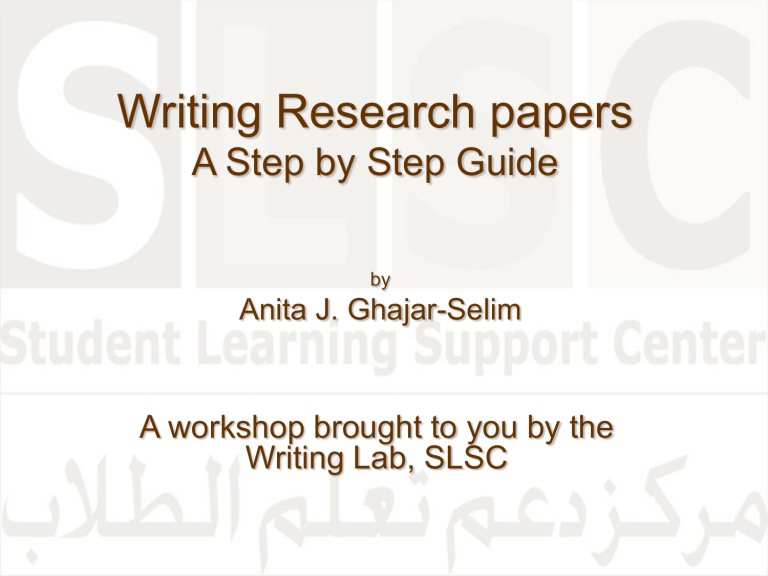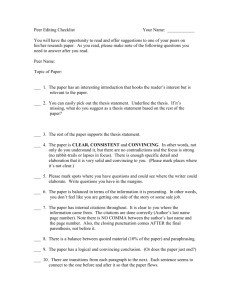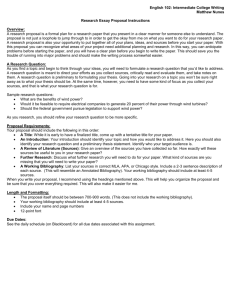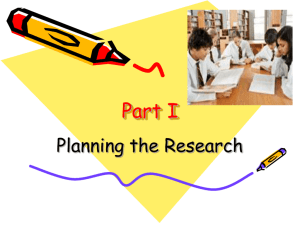How to Write a

Writing Research papers
A Step by Step Guide
by
Anita J. Ghajar-Selim
A workshop brought to you by the
Writing Lab, SLSC
Step One
Preliminaries
A. Choose a topic: Topics should
– Be specific
– Examine one important issue
– Argue from a thesis statement, enthymeme, or hypothesis
– Have a serious purpose
B. Begin Preliminary Reading
C. Restrict the Subject
D. Develop a Preliminary Thesis Statement. Thesis
Statement Should be:
, or
Step Two
Gathering Data
A. Compile the working bibliography
B.
Prepare the bibliography on cards in correct form (3” by
5”)
C. Begin Extensive work in the library reference room; be sure to check
Step Three
Taking Notes
A. Develop a preliminary outline
B. Evaluate your source material; which is primary and which is secondary material?
• Types of Sources
• Evaluating Tests
Step Four
Writing the Paper
A. Develop the final outline
B. Prepare to write
– Put your note cards in the order that your outline is in
– Consider your real and imagined readers and how their expectations may affect your tone and style.
C. Write the rough draft
D. Check your documentation carefully
E. Revise and rewrite
F. Check the format of the text, citations notes, and bibliography
G. Proofread
Example of an analytical thesis statement
• An analysis of the Foundation Students’
Scores shows one challenge facing teachers: motivating students in the classroom.
* The paper that follows should:
• explain the analysis of the Foundation student’s scores
• explain the challenge facing teachers
Example of an expository
(explanatory) thesis statement
• The life of the typical college student in Qatar is characterized by time spent studying, attending class, and participating in different students’ clubs on campus.
* The paper that follows should:
• explain how students spend their time studying, attending class, and participating in different students’ clubs on campus.
Example of an argumentative thesis statement
• High school graduates in Qatar should be required to take a year off to study English in an English speaking country before entering QU in order to increase their language skill.
* The paper that follows should:
• present an argument and give evidence to support the claim that students should be sent off to an English speaking country before entering QU.
Primary Source
• Primary sources , such as diaries, letters, memoirs, journals, speeches, manuscripts, interviews and other such unpublished works, photographs, audio or video recordings, research reports in the natural or social sciences, or original literary or theatrical works.
Secondary Source
• Secondary sources, such as published works such as journal articles or books, but may include radio or television documentaries, or conference proceedings.
Source Test
• Specific Reference to Source: Does the writer indicate the particular individual or group making the statements used for evidence? Does the writer tell you enough about the source that you could easily find it yourself?
• Qualifications of the Source: Does the writer give you reason to believe that the source is competent and well informed in the area in question?
• Bias of the Source: Even if expert, is the source likely to be biased on the question? Could we easily predict the source’s position merely from a knowledge of his job, her political party, or organizations she works for?
• Factual Support: Does the source offer factual support for the position taken or simply state conclusions?
Direct Test
• Recency: Is the evidence too old to be of current relevance to the issue?
Would the source have had knowledge of recent developments or discoveries that might have bearing on the issue?
•
Sufficiency: Is their enough evidence to justify all of the claims being made from it?
• Logical Relevance: Does the claim made in the evidence provide a premise which logically justifies the conclusion offered? Can you reasonably draw the conclusion being urged based on what the evidence says?
• Internal Consistency: Does this source make claims that are contradicted by other claims from the same source?
• External Consistency: Are the claims made by this source consistent with general knowledge and other evidence? If not, does the writer account for this discrepancy?
Primary and Secondary Source Quiz
You're writing a research paper on the homeless problem in your town or city.
Which of the following sources would be a primary source for you and which a secondary?
1. A report from the Center on Budget and Policy Priorities: "Drifting
Apart: New Findings on Growing Income Disparities Between the
Rich, the Poor, and the Middle Class," 1990
2. An interview with two homeless persons in your town.
3. A book entitled The Undeserving Poor: From the War on Poverty to the War on Welfare by Michael Katz, 1989.
4. An article entitled "The Culture of Poverty" in On Understanding
Poverty: Perspectives from the Social Sciences.
5. An interview with a sociology professor who teaches a course that explores the homeless problem.
References
Some of the outline skeleton was taken from http://owl.English.purdue.edu/handouts/research/r
_ressteps.html
Co –compiler/writer/editor: Ahmed F. Selim at ahmed.selim@qu.edu.qa







